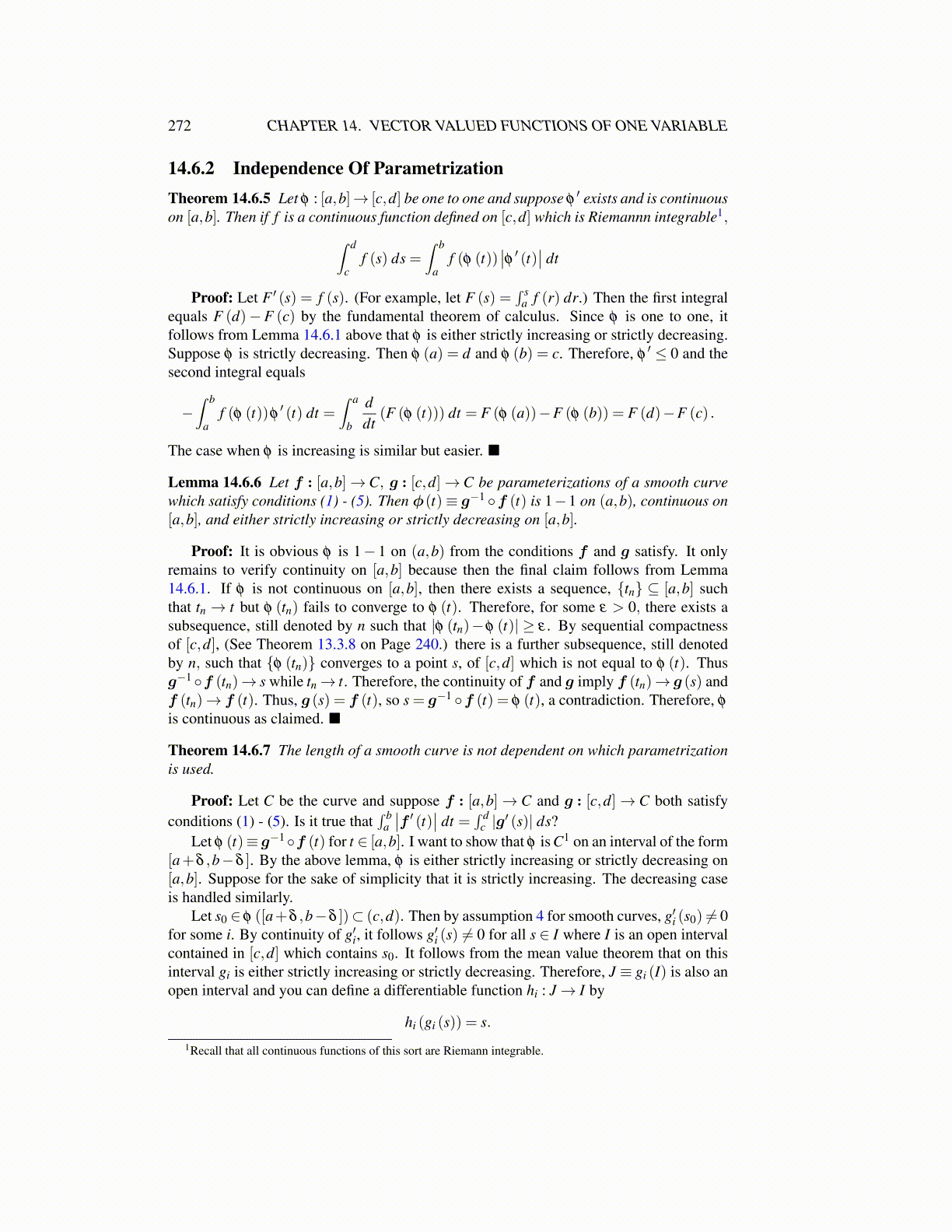
272 CHAPTER 14. VECTOR VALUED FUNCTIONS OF ONE VARIABLE
14.6.2 Independence Of ParametrizationTheorem 14.6.5 Let φ : [a,b]→ [c,d] be one to one and suppose φ
′ exists and is continuouson [a,b]. Then if f is a continuous function defined on [c,d] which is Riemannn integrable1,∫ d
cf (s) ds =
∫ b
af (φ (t))
∣∣φ ′ (t)∣∣ dt
Proof: Let F ′ (s) = f (s). (For example, let F (s) =∫ s
a f (r) dr.) Then the first integralequals F (d)−F (c) by the fundamental theorem of calculus. Since φ is one to one, itfollows from Lemma 14.6.1 above that φ is either strictly increasing or strictly decreasing.Suppose φ is strictly decreasing. Then φ (a) = d and φ (b) = c. Therefore, φ
′ ≤ 0 and thesecond integral equals
−∫ b
af (φ (t))φ
′ (t) dt =∫ a
b
ddt
(F (φ (t))) dt = F (φ (a))−F (φ (b)) = F (d)−F (c) .
The case when φ is increasing is similar but easier. ■
Lemma 14.6.6 Let f : [a,b]→C, g : [c,d]→C be parameterizations of a smooth curvewhich satisfy conditions (1) - (5). Then ϕ(t)≡ g−1 ◦f (t) is 1−1 on (a,b), continuous on[a,b], and either strictly increasing or strictly decreasing on [a,b].
Proof: It is obvious φ is 1− 1 on (a,b) from the conditions f and g satisfy. It onlyremains to verify continuity on [a,b] because then the final claim follows from Lemma14.6.1. If φ is not continuous on [a,b], then there exists a sequence, {tn} ⊆ [a,b] suchthat tn → t but φ (tn) fails to converge to φ (t). Therefore, for some ε > 0, there exists asubsequence, still denoted by n such that |φ (tn)−φ (t)| ≥ ε . By sequential compactnessof [c,d], (See Theorem 13.3.8 on Page 240.) there is a further subsequence, still denotedby n, such that {φ (tn)} converges to a point s, of [c,d] which is not equal to φ (t). Thusg−1 ◦f (tn)→ s while tn→ t. Therefore, the continuity of f and g imply f (tn)→ g (s) andf (tn)→ f (t). Thus, g (s) = f (t), so s = g−1 ◦f (t) = φ (t), a contradiction. Therefore, φ
is continuous as claimed. ■
Theorem 14.6.7 The length of a smooth curve is not dependent on which parametrizationis used.
Proof: Let C be the curve and suppose f : [a,b]→ C and g : [c,d]→ C both satisfyconditions (1) - (5). Is it true that
∫ ba
∣∣f ′ (t)∣∣ dt =∫ d
c |g′ (s)| ds?Let φ (t)≡ g−1◦f (t) for t ∈ [a,b]. I want to show that φ is C1 on an interval of the form
[a+δ ,b−δ ]. By the above lemma, φ is either strictly increasing or strictly decreasing on[a,b]. Suppose for the sake of simplicity that it is strictly increasing. The decreasing caseis handled similarly.
Let s0 ∈ φ ([a+δ ,b−δ ])⊂ (c,d). Then by assumption 4 for smooth curves, g′i (s0) ̸= 0for some i. By continuity of g′i, it follows g′i (s) ̸= 0 for all s ∈ I where I is an open intervalcontained in [c,d] which contains s0. It follows from the mean value theorem that on thisinterval gi is either strictly increasing or strictly decreasing. Therefore, J ≡ gi (I) is also anopen interval and you can define a differentiable function hi : J→ I by
hi (gi (s)) = s.
1Recall that all continuous functions of this sort are Riemann integrable.